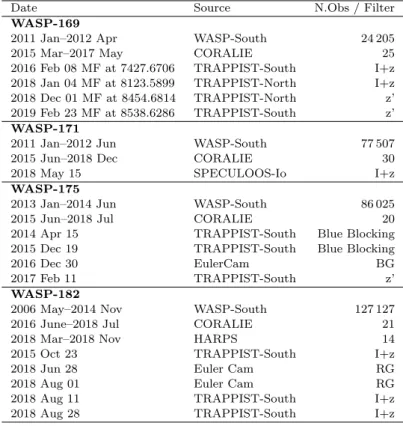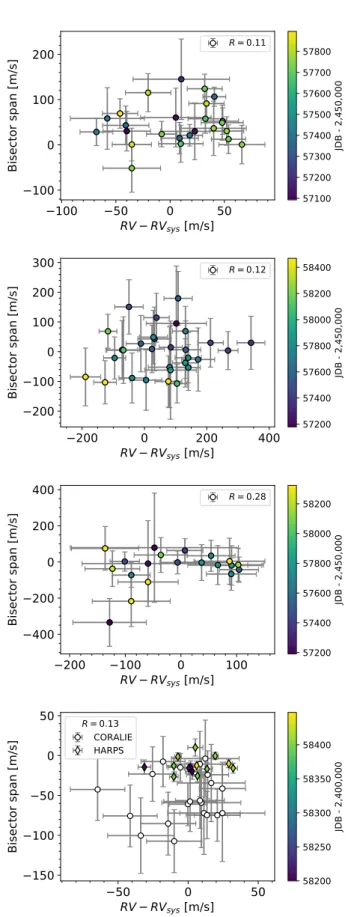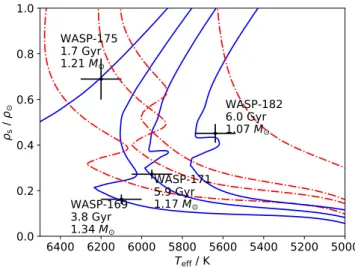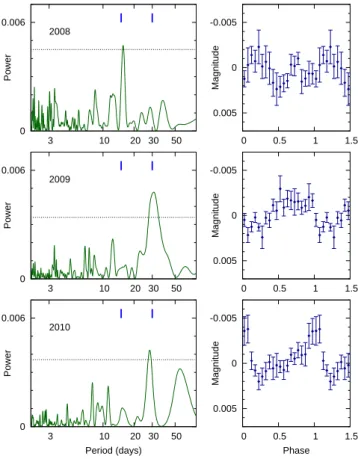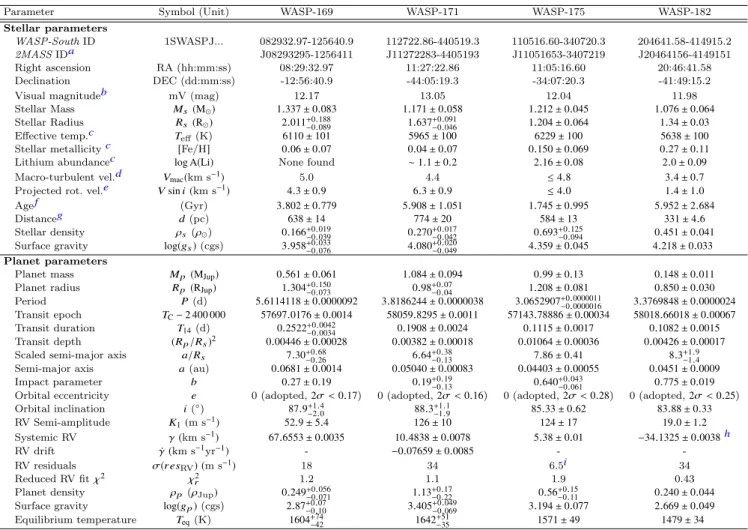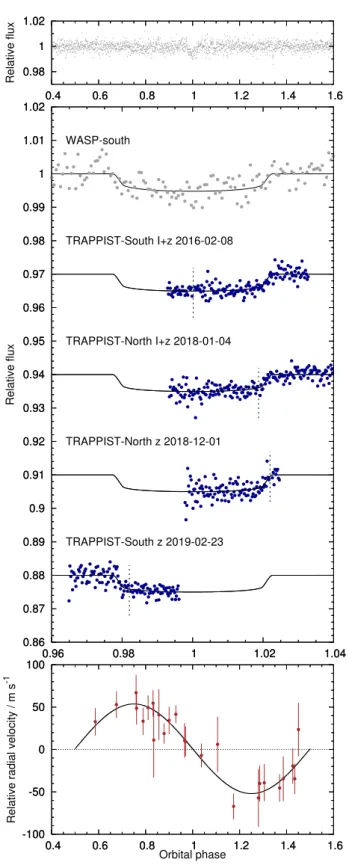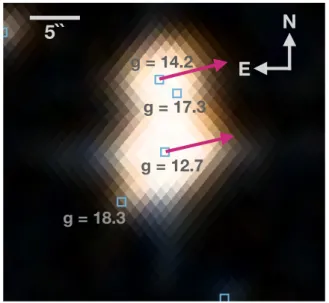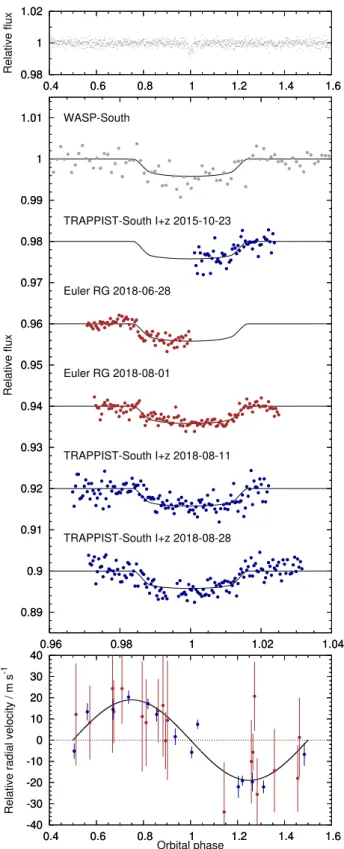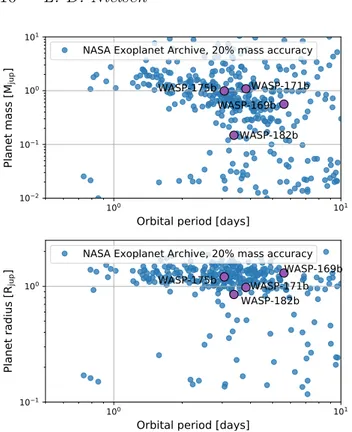WASP-169, WASP-171, WASP-175 and WASP-182: three
hot Jupiters and one bloated sub-Saturn mass planet
discovered by WASP-South
L. D. Nielsen,
1
?
F. Bouchy,
1
O. D. Turner,
1
D.R. Anderson,
2
K. Barkaoui,
3,4
Z. Benkhaldoun
4
A. Burdanov,
3
A. Collier Cameron,
7
L. Delrez,
9,3
M. Gillon,
3
E. Ducrot,
3
C. Hellier,
2
E. Jehin,
3
M. Lendl,
1,8
P.F.L. Maxted,
2
F. Pepe,
1
D. Pollacco,
5,6
F.J. Pozuelos,
3
D. Queloz,
1,9
D. S´
egransan,
1
B. Smalley,
2
A.H.M.J. Triaud,
10
S. Udry,
1
and R.G. West
5,6
1Observatoire de Gen`eve, Universit´e de Gen`eve, 51 Chemin des Maillettes, 1290 Sauverny, Switzerland 2Astrophysics Group, Keele University, Staffordshire ST5 5BG, UK
3Space sciences, Technologies and Astrophysics Research (STAR) Institute, Universit´e de Li`ege, Li`ege 1, Belgium
4Oukaimeden Observatory, High Energy Physics and Astrophysics Laboratory, Cadi Ayyad University, Marrakech, Morocco 5Department of Physics, University of Warwick, Coventry CV4 7AL, UK
6Centre for Exoplanets and Habitability, University of Warwick, Gibbet Hill Road, Coventry CV4 7AL, UK 7SUPA, School of Physics and Astronomy, University of St. Andrews, North Haugh, Fife KY16 9SS, UK 8Space Research Institute, Austrian Academy of Sciences, Schmiedlstr. 6, A-8042 Graz, Austria
9Cavendish Laboratory, J J Thomson Avenue, Cambridge CB3 0HE, UK
10School of Physics & Astronomy, University of Birmingham, Edgbaston, Birmingham, B15 2TT, UK
Accepted XXX. Received YYY; in original form ZZZ
ABSTRACT
We present the discovery of four new giant planets from WASP-South, three hot Jupiters and one bloated sub-Saturn mass planet; 169b, 171b, WASP-175b and WASP-182b. Besides the discovery photometry from WASP-South we use radial velocity measurements from CORALIE and HARPS as well as follow-up pho-tometry from EulerCam, TRAPPIST-North and -South and SPECULOOS.
WASP-169b is a low density Jupiter (M = 0.561 ± 0.061 MJup, R = 1.304+0.150−0.073 RJup)
orbiting a V=12.17 F8 sub-giant in a 5.611 day orbit.
WASP-171b is a typical hot Jupiter (M = 1.084 ± 0.094 MJup, R = 0.98+0.07−0.04 RJup,
P= 3.82 days) around a V=13.05 G0 star. We find a linear drift in the radial veloci-ties of WASP-171 spanning 3.5 years, indicating the possibility of an additional outer planet or stellar companion.
WASP-175b is an inflated hot Jupiter (M = 0.99 ± 0.13 MJup, R = 1.208 ± 0.081 RJup,
P= 3.07 days) around a V=12.04 F7 star, which possibly is part of a binary system with a star 7.900away.
WASP-182b is a bloated sub-Saturn mass planet (M = 0.148 ± 0.011 MJup, R =
0.850 ± 0.030 RJup) around a metal rich V=11.98 G5 star ([Fe/H]= 0.27 ± 0.11). With
a orbital period of P = 3.377 days, it sits right in the apex of the sub-Jovian desert, bordering the upper- and lower edge of the desert in both the mass-period and radius-period plane.
WASP-169b, WASP-175b and WASP-182b are promising targets for atmospheric char-acterisation through transmission spectroscopy, with expected transmission signals of 121, 150 and 264 ppm respectively.
Key words: planets and satellites: detection – planets and satellites: individual: WASP-169b – planets and satellites: individual: WASP-171b – planets and satellites: individual: WASP-175b – planets and satellites: individual: WASP-182b
? E-mail: Louise.Nielsen@unige.ch
© 2019 The Authors
1 INTRODUCTION
The Wide Angle Search for Planets (WASP;Pollacco et al. 2006) survey has since first light in 2006 discovered almost 200 transiting, close-in, giant exoplanets. These planets have provided great insight into exoplanetology as they enable studies of bulk properties, mass and radius from the transit photometry and radial velocity (RV) follow-up. Furthermore WASP have provided prime targets for in-depth charac-terisation of star-planet-interactions, exoplanet atmospheres (Birkby et al. 2013; de Kok et al. 2013), planetary winds (Brogi et al. 2016) and even the radial velocity shift of the planets themselves (Snellen et al. 2010).
Furthermore, WASP and other wide field ground based surveys has been instrumental in discovering exoplanets bor-dering the sub-Jovian desert. The desert is constituted by a shortage of intermediate sized planets (1.0 - 0.1 RJup) in close-in orbits (period < 5 days) (Szab´o & Kiss 2011;Mazeh et al. 2016; Fulton & Petigura 2018). This phenomenon is evident when analysing the distribution of periods for exo-planets as a function of both planetary radius and mass, as illustrated in Fig.10. Ground based surveys have tradition-ally targeted planets sitting on the upper edge of the desert, due to detection limits. A notable exception to this rule is NGTS-4b (West et al. 2019); a sub-Neptune-sized planet in a 1.34 days orbit around a K-dwarf. NGTS-4b, is situated well within the sub-Jovian desert, challenging current theories of photo evaporation.
Space based surveys, in particular Kepler (Borucki et al. 2010), have provided more targets constraining the lower edge, but mainly in the radius-period plane, as many of these targets are too faint for ground based follow up. The Transit-ing Exoplanet Survey Satellite, (TESS,Ricker et al. 2015), is now changing the landscape of exoplanetology providing hundreds of transiting exoplanet candidates around bright stars, most of them appropriate for mass characterisation with RVs.
In this study we present four giant planets discovered with WASP-South; three hot Jupiters and one bloated sub-Saturn mass planet: WASP-169b, WASP-171b, WASP-175b and WASP-182b, all orbiting relatively bright G- and F-type stars. We perform a global MCMC analysis of the discovery data from WASP-South, follow-up photometry from Euler-Cam, TRAPPIST-North, TRAPPIST-South and SPECU-LOOS and RVs from CORALIE and HARPS. WASP-169b
is a low density Jupiter (M = 0.561 ± 0.061 MJup, R =
1.304+0.150−0.073 RJup, P = 5.611 days) as well as WASP-175b
(M= 0.99 ± 0.13 MJup, R = 1.208 ± 0.081 RJup, P= 3.07 days), making them interesting targets for atmopherics character-isation. WASP-171b is a typical hot Jupiter (M = 1.084 ± 0.094 MJup, R = 0.98+0.07−0.04 RJup, P = 3.82 days) with a
pos-sible additional companion indicated by a linear drift in the RVs. WASP-182b is a bloated sub-Saturn mass planet (M= 0.148±0.011 MJup, R = 0.850±0.030 RJup, P = 3.377 days)
sitting in the apex of the sub-Jovian desert, bordering the upper- and lower edge of the desert in both the radius-period and mass-period plane.
Table 1. Summary of the discovery photometry, follow-up pho-tometry and radial velocity observations of 169, WASP-171, WASP-175 and WASP-182 from all facilities. Note time of meridian flip (MF) for WASP-169 on the TRAPPIST telescopes in BJD (−2 450 000).
Date Source N.Obs / Filter
WASP-169
2011 Jan–2012 Apr WASP-South 24 205
2015 Mar–2017 May CORALIE 25
2016 Feb 08 MF at 7427.6706 TRAPPIST-South I+z 2018 Jan 04 MF at 8123.5899 TRAPPIST-North I+z 2018 Dec 01 MF at 8454.6814 TRAPPIST-North z’ 2019 Feb 23 MF at 8538.6286 TRAPPIST-South z’ WASP-171
2011 Jan–2012 Jun WASP-South 77 507
2015 Jun–2018 Dec CORALIE 30
2018 May 15 SPECULOOS-Io I+z
WASP-175
2013 Jan–2014 Jun WASP-South 86 025
2015 Jun–2018 Jul CORALIE 20
2014 Apr 15 TRAPPIST-South Blue Blocking 2015 Dec 19 TRAPPIST-South Blue Blocking
2016 Dec 30 EulerCam BG
2017 Feb 11 TRAPPIST-South z’
WASP-182
2006 May–2014 Nov WASP-South 127 127
2016 June–2018 Jul CORALIE 21
2018 Mar–2018 Nov HARPS 14
2015 Oct 23 TRAPPIST-South I+z
2018 Jun 28 Euler Cam RG
2018 Aug 01 Euler Cam RG
2018 Aug 11 TRAPPIST-South I+z
2018 Aug 28 TRAPPIST-South I+z
2 OBSERVATIONS
2.1 Discovery photometry from WASP-south
The host stars of the four planets presented in this pa-per have been surveyed by WASP-South spanning several years, with WASP-182 being the target monitored for the longest time, dating back to 2006. WASP-South consisted, during the observations reported here, of eight 20 cm in-dividual f /1.8 lenses mounted on the same fixture. Each lense was equipped with a 2kx2k CCD with a plate scale of 13.700/pixel. The wide 7.8◦x7.8◦ field of view, allowed WASP-South to cover 1% of the sky in each pointing, tar-geting stars with mV 9-13. The 20-cm lenses has since been replaced with 85 mm lenses, allowing the survey to target planets around brighter stars such WASP-189b (Anderson et al. 2018).
Transit events are searched for in the discovery pho-tometry using the box least square method as described in
Collier Cameron et al. (2006). Targets with transits con-sistent with a planet-sized object are ranked according to
Collier Cameron et al.(2007) and put forward for follow-up observations with a wide range of facilities. Both high resolution spectroscopy and photometry is used to confirm the planetary nature of the transiting object and ultimately measure both mass and radius precisely as described in the following sections. A summary of the observations used in this study can be found in Table1.
Table 2. The first five radial velocity measurements for WASP-169 from CORALIE, along with RV uncertainties,σRV, FWHM
of the CCF and bisector-spans. BJD is barycentric Jullian dates. Full machine-readable tables for all four stars are available with the online journal.
Time RV σRV FWHM Bisector (BJD - 2 400 000) (km s−1) (km s−1) (km s−1) (km s−1) 57092.695347 67.61532 0.02192 10.45130 0.03031 57119.639402 67.66054 0.03251 10.57522 0.06030 57121.569521 67.67801 0.03145 10.42107 0.02989 57185.451344 67.66557 0.04442 10.53662 0.14495 57365.775616 67.66402 0.01734 10.41273 0.01473 ... ... ... ... ... 2.2 CORALIE spectroscopy
Several spectra at different epochs were obtained for all four targets using the high resolution spectrograph CORALIE on the Swiss 1.2-m Euler telescope at La Silla Observatory, Chile (Queloz et al. 2001). CORALIE has a resolving power of R ∼ 60 000 and is fed by two fibres; one 200on-sky science fibre encompassing the star and another which can either be connected to a Fabry-P´erot etalon for simultaneous wave-length calibration or on-sky for background subtraction of the sky-flux. For WASP-169, WASP-171 and WASP-175 the CORALIE spectra were used to derive stellar parameters, see Sec.3.1for a detailed description of the analysis.
We obtained RVs for each epoch by cross-correlating with a binary G2 mask (Pepe et al. 2002). Bisector-span, FWHM and other line-profile diagnostics were computed as well. Figure1shows RVs and bisector span for the four stars, with Pearson-coefficients. No correlation was found between the RVs and the bisector-span. We also computed RVs using other binary masks ranging from A0 to M4, to check for any mask-dependent signal indicating a blend. As such, the CORALIE RVs confirm the planetary nature of the transit signals and we found them all to be in phase with the transit events detected by WASP-South.
Table 2 show the 5 first RVs of WASP-169 from
CORALIE, along with RV uncertainty, FWHM of the CCF and bisector span. Full ascii tabels with all the RV data presented in this study are available online.
2.3 HARPS spectroscopy
To enable precise mass measurement of WASP-182b we also obtained HARPS RVs under programmes Anderson: 0100.C-0847 and Nielsen: 0102.C-0414 in 2018. HARPS is hosted by the ESO 3.6-m telescope at La Silla Observatory, Chile (Mayor et al. 2003) and has a resolving power of R ∼ 100 000. The RVs were computed using the standard data-reduction pipeline with a binary G2 mask, and confirmed the RV-amplitude found with CORALIE, though with greater pre-cision. The HARPS spectra were also used to derive spectral parameters for WASP-182, as detailed in Sec.3.1.
2.4 EulerCam
Additional photometry was acquired for WASP-175 and WASP-182 using EulerCam (Lendl et al. 2012), also on the 1.2-m Swiss at La Silla Observatory. The observations used B and R filters, respectively. The data were bias and flat
100
50
0
50
RV RVsys
[m/s]
100
0
100
200
Bisector span [m/s]
R = 0.11 57100 57200 57300 57400 57500 57600 57700 57800 JDB - 2,450,000200
0
200
400
RV RVsys
[m/s]
200
100
0
100
200
300
Bisector span [m/s]
R = 0.12 57200 57400 57600 57800 58000 58200 58400 JDB - 2,450,000200
100
0
100
RV RVsys
[m/s]
400
200
0
200
400
Bisector span [m/s]
R = 0.28 57200 57400 57600 57800 58000 58200 JDB - 2,450,00050
0
50
RV RVsys
[m/s]
150
100
50
0
50
Bisector span [m/s]
R = 0.13 CORALIE HARPS 58200 58250 58300 58350 58400 JDB - 2,400,000Figure 1. Bisector-span and RVs for WASP-169, WASP-171, WASP-175 and WASP-182 from top to bottom panel. The Pear-son coefficient R shows there are no correlation between the bisector-span and RVs. For WASP-182 no offset in bisector span from CORALIE to HARPS were corrected for, and the Pearson coefficient is for the HARPS RVs only.
field corrected and photometry extracted for a number of comparison stars and aperture radii. The comparison star ensemble and aperture radii chosen such that the scatter in a simple linear fit to the out of transit portion was min-imised. The aim of this process was to produce a final light curve optimised to reduce the overall scatter.
2.5 TRAPPIST-North and -South
Both of the two 0.6-m TRAPPIST telescopes (Gillon et al. 2011;Jehin et al. 2011), based at La Silla and Oukaimeden Observatory in Morocco (Gillon et al. 2017;Barkaoui et al. 2019) were used to perform follow-up photometry on 169, 175 and 182. All light curves of WASP-169 contain a meridian flip (MF), as detailed in Table1. In the joint analysis of the RVs and photometry, described in Section4, the data were partitioned at the time of MF and modelled as two independent data sets.
Data reduction consisted of standard calibration steps (bias, dark and flat-field corrections) and subsequent
aper-ture photometry using IRAF/DAOPHOT (Tody 1986).
Ex-traction of fluxes of selected stars using aperture photome-try was performed with IRAF/DAOPHOT, as described in
Gillon et al.(2013).
2.6 SPECULOOS-South
The robotic 1-m SSO-Io telescope is one of four telescopes at the SPECULOOS-South facility located at Paranal Ob-servatory, Chile (Jehin et al. 2018;Delrez et al. 2018;Gillon 2018;Burdanov et al. 2018). It started its science operations in 2017 and observed one full transit of WASP-171 in May 2018 using a I+z filter, toward the near-infrared end of the visible spectrum. The SPECULOOS telescopes are equipped with 2Kx2K CCD cameras, with increased sensitivities up to 1µm, in the very-near-infrared. The calibration and pho-tometric reduction of the data were performed as described inGillon et al.(2013).
3 STELLAR PARAMETERS
3.1 Spectral characterisation
Following the methods described in Doyle et al.(2013) we used the CORALIE and HARPS spectra to derive stellar parameters. Effective temperature, Teff, is computed from
the Hα-line. Surface gravity, log g, is based on Na I D and Mg I b lines. The metallicity, [Fe/H], is determined from the equivalent-width of a selection of unblended Fe-lines. Lithium abundances which can be used to gauge stellar age and has been proposed to be a tracer of planet formation (King et al. 1997;Figueira et al. 2014), are derived as well. The uncertainty on Teff and log g is propagated through to
the abundances.
The projected rotational velocity, V sin i, is found by convoluting the width of stellar absorption lines with the instrumental resolution (R ∼ 60 000 for CORALIE and R ∼ 100 000 for HARPS) and modelling macro turbulence by the method proposed inDoyle et al.(2014). Micro turbu-lence was estimated using the calibration fromBruntt et al.
(2012). 5000 5200 5400 5600 5800 6000 6200 6400 Teff / K 0.0 0.2 0.4 0.6 0.8 1.0 ρs / ρ⊙ WASP⊙169 3.8 Gyr 1.34 M⊙ WASP⊙171 5.9 Gyr 1.17 M⊙ WASP⊙175 1.7 Gyr 1.21 M⊙ WASP⊙182 6.0 Gyr 1.07 M⊙
Figure 2. Isochrones (solid/blue) and evolution tracks (dot-dashed/red) output by BAGEMASS for each of the four host stars (labelled).
3.2 Stellar masses and ages with BAGEMASS
We used the Bayesian stellar evolution code BAGEMASS (Maxted et al. 2015) to model stellar masses and ages based on spectral Teff and [Fe/H] as well as the stellar density
de-rived from the transit-light curves. BAGEMASS samples a dense grid of stellar models to compute stellar masses and ages. The stellar masses obtained were used as Gaussian inputs in the final joint model. Figure2 shows the stellar evolutionary tracks and isochrones for all four planet host stars. All adopted stellar parameters from spectral charac-terisation, BAGEMASS, and the final joint model are listed in Table3.
3.3 Rotational modulation
We searched for rotational modulation caused by stellar spots in the WASP-South light curves for the four host stars using the method described inMaxted et al. (2011). Star spots have limited lifetimes and will have variable distribu-tion on the stellar surface over time. Therefore the modu-lation is not expected to be coherent, and so we searched each season of WASP-South data individually. WASP-169 and WASP-171 showed no significant modulation, with an upper limit on the amplitude of 1.5 mmag. For WASP-175 we can set an upper limit of 2 mmag.
For WASP-182 we find a possible modulation in the data from both 2009 and 2010, with a false-alarm probability of 1% in each case. The modulation has a period of 30 +/-2 days and an amplitude of 1 to +/-2 mmag, which is near the detection limit in WASP-South data. In 2008 we saw a peak near (but not exactly at) half the period seen in 2009 and 2010, which could thus be the first harmonic of the rotational modulation (see Fig.3). The exact position of the strongest peak in the data from 2009 and 2010 differ slightly. This could be a result of us tracking star spots at different latitudes on the stellar disk between the two seasons, which in the presence of differential rotation will cause a phase shift in modulation. Another possibility is star-spot groups coming and going during the season, which also will induce
0 0.006 3 10 20 30 50 Power Period (days) 2010 0 0.006 3 10 20 30 50 Power 2009 0 0.006 3 10 20 30 50 Power 2008 -0.005 0 0.005 0 0.5 1 1.5 Magnitude Phase -0.005 0 0.005 0 0.5 1 1.5 Magnitude -0.005 0 0.005 0 0.5 1 1.5 Magnitude
Figure 3. Periodograms of the WASP-South data for WASP-182 from three different years (left) along with folds of the data at the possible rotational periods (right). The folded data has been binned to 20 bins, each corresponding to 1.5 nights. The blue marks are at 30 and 15 days and the dotted horizontal line at 1% FAP.
a period shift in the periodogram. In data both before (2006 and 2007) and after (2011 and 2012) these years we see no significant modulation, though in each case the data are less extensive than in 2009 and 2010. The 30-day rotation period corresponds to a rotational velocity of about 2 km/s and is consistent with the V sin i computed from HARPS spectra (1.4 ± 1.0 km/s).
4 SYSTEM PARAMETERS
The full set of system parameters were modelled jointly us-ing the discovery photometry, follow-up light curves and RV data with the Markov-Chain Monte Carlo (MCMC) code described in detail inCollier Cameron et al.(2007) and An-derson et al.(2015). The analytic eclipse-expressions derived byMandel & Agol(2002) are used with a 4 parameters, non-linear limb darkening law of Claret(2000,2004). We have interpolated coefficients for stellar temperature and metal-licity of each star, and in each photometric filter. The
val-ues used were perturbed during the MCMC via TL−D, the
‘limb-darkening temperature’, which has a mean and stan-dard deviation corresponding to the spectroscopic Teff and its uncertainty.
We ran the MCMC both with the eccentricity as a free
parameter and fixed to zero, to check if the results are com-patible with a circular orbit. We expect most giant planets in short period orbits to have been circularised by tidal forces, and want to avoid over-estimating the eccentricity in orbits that have none. Each circular model has 6 fitted parameters; orbital period , P, epoch, TC, transit depth in the absences
of dark limb effects, (Rp/Rs)2, transit duration, T14, impact
parameters, b and stellar radial velocity semi-amplitude, K1.
The RV systemic velocityγ was fitted too, and in the case of WASP-171 along with a linear RV-drift, Ûγ. For WASP-182, where we have data from two different spectrographs, an offset between CORALIE and HARPS was modelled as well.
For each target we ran 5000 MCMC steps as a ’burn in phase’ to initialise the main phase which was set to have 50 000 iterations. At each step the free parameters are per-turbed and the models are re-fit. If theχ2of the fit is better than the previous step the current parameters are accepted, if the fit is worse the parameters are accepted with a prob-ability proportional to exp(−∆ χ2). We used Gelman-Rubin statistics (Gelman et al. 2003;Ford 2006) to check how well the chains converge. In our case the Gelman-Rubin statistics indicated that all fitted parameters were well mixed.
Continuing our practice from recent discovery papers (e.g. Hellier et al. 2019) we treat the stellar parameters through a two-step process; we first estimate the stellar den-sity, ρS, from the transit duration alone, independently of
stellar models. Secondly we obtain stellar masses by using ρS, Teff and [Fe/H] in the stellar evolution model
BAGE-MASS, as explained in Section3.2. The resulting stellar mass estimate and its uncertainty is finally used as input in the MCMC to derive stellar radii. The stellar density for WASP-182 is poorly constrained by the transit data alone, so we used an additional prior on the radius from Gaia DR2, as described inTurner et al.(2019).
5 RESULTS
For each system we list the final stellar and planetary param-eters in Table3with 1-σ errors. Figures4through8show the final joint model fitted to the discovery and follow-up data.
5.1 WASP-169b
WASP-169b is a low density Jupiter with mass 0.561 ± 0.061 MJup and radius 1.304+0.150−0.073 RJup in a 5.611 day
or-bit around a V=12.17 F8 sub-giant. Figure 4 shows the
WASP-South discovery light curve with follow-up obser-vations from TRAPPIST-North, -South and CORALIE. The planetary and stellar parameters are well constrained. The transit log(gs) = 3.958+0.033−0.076 (cgs) is consistent with
the spectroscopic value of 4.0 ± 0.2. The resulting stel-lar radius (2.011+0.188−0.089R ) is in agreement with Gaia DR2
(2.28+0.10−0.25R ). WASP-169 has a faint star 700 away with
∆g=5.4 (Gaia Collaboration et al. 2018). It has a similar parallax (1.26 ± 0.09 mas vs 1.566 ± 0.04 mas), but does not appear to be co-moving.
The low density of WASP-169b (0.249+0.056
−0.071ρjup) should
make it a good candidate for atmospheric characterisation. It has an estimated scale height of 1300 km, corresponding
Table 3. System parameters for WASP-169, WASP-171, WASP-175 and WASP-182, based on the analysis presented in Section3&4. Adopted non SI-units are M = 1.9891 · 1030kg, R = 6.95508 · 108m, RJup= 7.149253763 · 107m and MJup= M /1047.52.
Parameter Symbol (Unit) WASP-169 WASP-171 WASP-175 WASP-182
Stellar parameters
WASP-South ID 1SWASPJ... 082932.97-125640.9 112722.86-440519.3 110516.60-340720.3 204641.58-414915.2
2MASS IDa J08293295-1256411 J11272283-4405193 J11051653-3407219 J20464156-4149151
Right ascension RA (hh:mm:ss) 08:29:32.97 11:27:22.86 11:05:16.60 20:46:41.58
Declination DEC (dd:mm:ss) -12:56:40.9 -44:05:19.3 -34:07:20.3 -41:49:15.2
Visual magnitudeb mV (mag) 12.17 13.05 12.04 11.98
Stellar Mass Ms(M ) 1.337 ± 0.083 1.171 ± 0.058 1.212 ± 0.045 1.076 ± 0.064
Stellar Radius Rs(R ) 2.011+0.188−0.089 1.637+0.091−0.046 1.204 ± 0.064 1.34 ± 0.03
Effective temp.c Teff(K) 6110 ± 101 5965 ± 100 6229 ± 100 5638 ± 100
Stellar metallicityc [Fe/H] 0.06 ± 0.07 0.04 ± 0.07 0.150 ± 0.069 0.27 ± 0.11
Lithium abundancec log A(Li) None found ∼ 1.1 ± 0.2 2.16 ± 0.08 2.0 ± 0.09
Macro-turbulent vel.d Vmac(km s−1) 5.0 4.4 ≤ 4.8 3.4 ± 0.7
Projected rot. vel.e Vsin i (km s−1) 4.3 ± 0.9 6.3 ± 0.9 ≤ 4.0 1.4 ± 1.0
Agef (Gyr) 3.802 ± 0.779 5.908 ± 1.051 1.745 ± 0.995 5.952 ± 2.684
Distanceg d (pc) 638 ± 14 774 ± 20 584 ± 13 331 ± 4.6
Stellar density ρs(ρ ) 0.166+0.019−0.039 0.270+0.017−0.042 0.693+0.125−0.094 0.451 ± 0.041
Surface gravity log(gs) (cgs) 3.958+0.033−0.076 4.080+0.020−0.049 4.359 ± 0.045 4.218 ± 0.033
Planet parameters
Planet mass Mp(MJup) 0.561 ± 0.061 1.084 ± 0.094 0.99 ± 0.13 0.148 ± 0.011
Planet radius Rp(RJup) 1.304+0.150−0.073 0.98+0.07−0.04 1.208 ± 0.081 0.850 ± 0.030
Period P (d) 5.6114118 ± 0.0000092 3.8186244 ± 0.0000038 3.0652907+0.0000011−0.0000016 3.3769848 ± 0.0000024
Transit epoch TC− 2 400 000 57697.0176 ± 0.0014 58059.8295 ± 0.0011 57143.78886 ± 0.00034 58018.66018 ± 0.00067
Transit duration T14(d) 0.2522+0.0042−0.0034 0.1908 ± 0.0024 0.1115 ± 0.0017 0.1082 ± 0.0015
Transit depth (Rp/Rs)2 0.00446 ± 0.00028 0.00382 ± 0.00018 0.01064 ± 0.00036 0.00426 ± 0.00017
Scaled semi-major axis a/Rs 7.30+0.68−0.26 6.64+0.38−0.13 7.86 ± 0.41 8.3+1.9−1.4
Semi-major axis a (au) 0.0681 ± 0.0014 0.05040 ± 0.00083 0.04403 ± 0.00055 0.0451 ± 0.0009
Impact parameter b 0.27 ± 0.19 0.19+0.19−0.13 0.640+0.043−0.061 0.775 ± 0.019
Orbital eccentricity e 0 (adopted, 2σ < 0.17) 0 (adopted, 2σ < 0.16) 0 (adopted, 2σ < 0.28) 0 (adopted, 2σ < 0.25)
Orbital inclination i (◦) 87.9+1.4−2.0 88.3+1.1−1.9 85.33 ± 0.62 83.88 ± 0.33 RV Semi-amplitude K1(m s−1) 52.9 ± 5.4 126 ± 10 124 ± 17 19.0 ± 1.2 Systemic RV γ (km s−1) 67.6553 ± 0.0035 10.4838 ± 0.0078 5.38 ± 0.01 −34.1325 ± 0.0038h RV drift γ (km sÛ −1yr−1) - −0.07659 ± 0.0085 - -RV residuals σ(resRV) (m s−1) 18 34 6.5i 34 Reduced RV fitχ2 χ2 r 1.2 1.1 1.9 0.43
Planet density ρp(ρJup) 0.249+0.056−0.071 1.13+0.17−0.22 0.56+0.15−0.11 0.240 ± 0.044
Surface gravity log(gp) (cgs) 2.87+0.07−0.10 3.405+0.049−0.069 3.194 ± 0.077 2.669 ± 0.049
Equilibrium temperature Teq(K) 1604+74−42 1642+51−35 1571 ± 49 1479 ± 34
a Cutri et al.(2003)
b From NOMAD (Zacharias et al. 2004)
c From spectral analysis of CORALIE spectra (HARPS for WASP-182 (Sec.3.1) d Derived via the method byDoyle et al.(2014) on CORALIE and HARPS spectra e Derived from CORALIE and HARPS spectra, assuming Macro-turbulent velocityd f From BAGEMASS analysis (Sec.3.2)
g From Gaia DR2 parallax (Gaia Collaboration et al. 2016,2018) h RV offset of 31.9 ± 0.2 m s−1from CORALIE to HARPS is found.
i RV residual for HARPS and CORALIE combined.
to a transmission signal of 121 ppm. The JWST instrument NIRSpec will uniquely be able to cover the near-infrared
spectral range from 0.6 to 5.3 µm in one low resolution
spectrum in ’PRISM mode’ (Birkmann et al. 2016). With
a J-band magnitude of 10.8, WASP-169 is a perfect target for NIRSpec, expecting to achieving SNR 10 000 - 25 000 per resolution element across the spectrum with one transit (Nielsen et al. 2016;Batalha et al. 2017).
5.2 WASP-171b
WASP-171 is a V=13.05 G0 star which also appears to be slightly evolved. The transit log(gs) = 4.080+0.020−0.049 (cgs)
is consistent with the spectroscopic value of 4.1 ± 0.2. We do find a slight discrepancy between our radius estimate
(1.637+0.091−0.046R ) and the Gaia DR2 value (2.11+0.04−0.2 R ),
though they are consistent to 2σ. The Gaia measurements do not seem to be affected by any excess astrometric or pho-totmetric noise.
WASP-171b is found to have a mass of 1.0841 ± 0.094 MJupand radius 0.98+0.07−0.04RJup, fitting the characteris-tics of a fairly typical hot Jupiter. The orbital period is 3.82 days, making it the hottest planet presented in this paper with an equilibrium temperature of Teq = 1640±40 K. Figure
5shows the WASP-South discovery light curve with follow-up observations from SPECULOOS-Io and CORALIE. The RVs span a baseline of 3.6 years and show a linear drift of 77 ± 9 m s−1yr−1, indicating a third body further out in the system. With the data available we can put a minimum mass limit of 10 MJupon the outer object, though more
ob-0.98 1 1.02 0.4 0.6 0.8 1 1.2 1.4 1.6 Relative flux 0.98 1 1.02 0.4 0.6 0.8 1 1.2 1.4 1.6 0.86 0.87 0.88 0.89 0.9 0.91 0.92 0.93 0.94 0.95 0.96 0.97 0.98 0.99 1 1.01 1.02 0.96 0.98 1 1.02 1.04 WASP-south TRAPPIST-South I+z 2016-02-08 TRAPPIST-North I+z 2018-01-04 TRAPPIST-North z 2018-12-01 TRAPPIST-South z 2019-02-23 Relative flux 0.86 0.87 0.88 0.89 0.9 0.91 0.92 0.93 0.94 0.95 0.96 0.97 0.98 0.99 1 1.01 1.02 0.96 0.98 1 1.02 1.04 -100 -50 0 50 100 0.4 0.6 0.8 1 1.2 1.4 1.6
Relative radial velocity / m s
-1 Orbital phase -100 -50 0 50 100 0.4 0.6 0.8 1 1.2 1.4 1.6
Figure 4. Data for the WASP-169 system. Top: WASP discov-ery light curve phase-folded on period found by joint analysis and binned to 2 minutes. Middle: Light curves used in joint analysis. The WASP light curve has been binned to 5 minutes and is shown as grey points with the transit model overplotted. The follow-up light curves have been binned to 2 minutes and are here all from TRAPPIST-North and South shown in blue. Times of meridian flip are indicated as vertical dashed lines. Bottom: CORALIE ra-dial velocities used in the joint analysis over plotted with resulting model. 0.98 1 1.02 0.4 0.6 0.8 1 1.2 1.4 1.6 Relative flux 0.98 1 1.02 0.4 0.6 0.8 1 1.2 1.4 1.6 0.97 0.98 0.99 1 1.01 0.96 0.98 1 1.02 1.04 WASP-South SPECULOOS-Io I+z 2018-05-15 Relative flux 0.97 0.98 0.99 1 1.01 0.96 0.98 1 1.02 1.04 -150 -100 -50 0 50 100 150 0.4 0.6 0.8 1 1.2 1.4 1.6
Relative radial velocity / m s
-1 Orbital phase -150 -100 -50 0 50 100 150 0.4 0.6 0.8 1 1.2 1.4 1.6 -300 -200 -100 0 100 200 300 400 7200 7400 7600 7800 8000 8200 8400 Re la ti ve r ad ia l v el oc it y / m /s Date (BJD - 2,450,000.0) [d]
Figure 5. As for Fig.4for the WASP-171 system with the RV-timeseries added in the bottom panel. The best fit Keplerian model is over-plotted with the adopted linear trend. Data from SPECULOOS is shown in green in the second panel from the top.
servations are needed to constrain whether it is sub-stellar or not.
5.3 WASP-175b
WASP-175 is a V=12.04 F7 star with metallicity [Fe/H]= 0.150 ± 0.069. The transit log(gs) = 4.359 ± 0.045 (cgs) is
consistent with the spectroscopic value of 4.3 ± 0.2. Figure6shows the WASP-South discovery light curve with follow-up observations from TRAPPIST-South, Euler-Cam and CORALIE. The WASP-South light curve is diluted by a star 7.900away with ∆g= 1.5 (Gaia Collaboration et al. 2018). The fitted depth of the transit is driven by the follow-up photometry in which the two stars are spatially resolved.
0.98 1 1.02 0.4 0.6 0.8 1 1.2 1.4 1.6 Relative flux 0.98 1 1.02 0.4 0.6 0.8 1 1.2 1.4 1.6 0.86 0.87 0.88 0.89 0.9 0.91 0.92 0.93 0.94 0.95 0.96 0.97 0.98 0.99 1 1.01 1.02 0.96 0.98 1 1.02 1.04 WASP-South
TRAPPIST-South Blue Blocking 2014-04-15
TRAPPIST-South Blue Blocking 2015-12-19
Euler BG 2016-12-30 TRAPPIST-South z 2017-02-11 Relative flux 0.86 0.87 0.88 0.89 0.9 0.91 0.92 0.93 0.94 0.95 0.96 0.97 0.98 0.99 1 1.01 1.02 0.96 0.98 1 1.02 1.04 -150 -100 -50 0 50 100 150 0.4 0.6 0.8 1 1.2 1.4 1.6
Relative radial velocity / m s
-1 Orbital phase -150 -100 -50 0 50 100 150 0.4 0.6 0.8 1 1.2 1.4 1.6
Figure 6. As for Fig.4 for the WASP-175 system. Data from EulerCam is shown in red in the middle panel.
g = 18.3
g = 17.3
g = 12.7
g = 14.2
5``
N
E
Figure 7. DSS image of WASP-175 (centre) and the nearby com-panion 7.900north. Their common proper motions are indicated as pink arrows. Blue squares are GAIA DR2 sources in the field, with GAIA magnitudes denoted in grey.
The neighbouring star has similar Gaia DR2 parallax and is co-moving with WASP-175, indicating that the two stars might be in a wide S-type binary orbit. The projected sepa-ration of the two stars is 4600 AU. Fig.7shows the two stars with their common proper motion indicated as pink arrows, WASP-175 is the star in the centre of the image. There are two other faint GAIA sources in the field which do not share the same parallax. The companion to the north has GAIA radius 0.88 ± 0.10 R and effective temperature 5163+491−165 K.
WASP-175b has mass 0.99±0.13 MJupand radius 1.208±
0.081 RJup and orbits every 3.07 days at a distance of 0.044 AU. Much like the first discovery of a transiting exoplanet (HD 209458bCharbonneau et al. 2000) and many more since then, WASP175b fall in the category of hot Jupiters showing anomalous large radii, which cannot be explained by a H-He dominated planet interior (Baraffe et al. 2009). The low density of the planet (0.56+0.15−0.11ρjup) should make
WASP-175b a good candidate for atmospheric characterisation. It has an estimated scale height of 620 km, corresponding to a transmission signal of 150 ppm.
5.4 WASP-182b
WASP-182 is a V=11.98 G5 star with a high metallicity, [Fe/H]= 0.27 ± 0.11. The stellar density was poorly con-strained by the available photometric data, and we thus enforced a prior on the stellar radius from Gaia DR2 in the MCMC modelling. The resulting stellar surface gravity log(gs) = 4.218 ± 0.033 (cgs) is consistent with the
spectro-scopic value of 4.2 ± 0.2.
Figure8shows the WASP-South discovery light curve with follow-up observations from TRAPPIST-South, Euler-Cam, CORALIE and HARPS. With a RV semi-amplitude of 19.0 ± 1.2 ms−1a larger telescope was needed to precisely measure the mass of WASP-128b, and we thus obtained data with HARPS as well. The RV scatter around the best fit model is 6.5 ms−1. One point close to phase=0 (though not
0.98 1 1.02 0.4 0.6 0.8 1 1.2 1.4 1.6 Relative flux 0.98 1 1.02 0.4 0.6 0.8 1 1.2 1.4 1.6 0.89 0.9 0.91 0.92 0.93 0.94 0.95 0.96 0.97 0.98 0.99 1 1.01 0.96 0.98 1 1.02 1.04 WASP-South TRAPPIST-South I+z 2015-10-23 Euler RG 2018-06-28 Euler RG 2018-08-01 TRAPPIST-South I+z 2018-08-11 TRAPPIST-South I+z 2018-08-28 Relative flux 0.89 0.9 0.91 0.92 0.93 0.94 0.95 0.96 0.97 0.98 0.99 1 1.01 0.96 0.98 1 1.02 1.04 -40 -30 -20 -10 0 10 20 30 40 0.4 0.6 0.8 1 1.2 1.4 1.6
Relative radial velocity / m s
-1 Orbital phase -40 -30 -20 -10 0 10 20 30 40 0.4 0.6 0.8 1 1.2 1.4 1.6
Figure 8. As for Fig.6 for the WASP-182 system. Data from HARPS is shown in blue in the bottom panel.
102 101 100 101
Planet mass [M
jup]
0.5 1.0 1.5 2.0 2.5Pla
ne
t r
ad
ius
[R
jup]
NASA Exoplanet Archive, 20% mass accuracy (March 2019)Mass based on TTVs, NASA Exoplanet ArchiveWASP-169b
WASP-171b
WASP-175b
WASP-182b
Figure 9. Masses and radii of the four planets presented in this paper, WASP-169b, WASP-171b, WASP-175b and WASP-182b, along with the known exoplanet population. Only planets with masses determined to 20% or better are included, and mass-estimates based on TTVs are in grey.
in-transit) shows a relatively large offset (7 ms−1) from the joint fit. It does not appear to be affected by stellar activ-ity or other systematic effects, so we have included it in the analysis for completion. Using the WASP-South photometry we constrain the stellar rotation period to 30 ± 2 days, which is consistent with a G-star on the main sequence (McQuillan et al. 2014). The RVs show no variability, as a sign of stellar activity, at that period.
WASP-182b is found to have a mass of 0.148±0.011 MJup
and radius 0.850 ± 0.030 RJup, making it a low density planet.
The estimated scale height is 1930 km, corresponding to 264 ppm. With a period of 3.38 days WASP-182b sits right between the lower and upper edges of the sub-Jovian desert in both the mass- and radius plane, as seen in Fig.9. This makes it an even more compelling target for in-depth atmo-spheric characterisation, studying possible atmoatmo-spheric es-cape close to the evaporation desert (Owen 2019;Ehrenreich et al. 2015;Bourrier et al. 2018).
6 DISCUSSION & CONCLUSION
We have presented the discovery and mass determination of four new Jovian planets from the WASP-South survey. Fig.
9 presents these planets along with the mass and radii of the known exoplanet population, as per March 2019. Only planets with masses determined to a fractional accuracy of 20% or better are included, and mass-estimates based on transit-timing variations (TTVs) are distinguished in grey.
WASP-169b, WASP-171b and WASP-175b fall within the category of hot Jupiters, with 169b and WASP-175b being inflated. Having precise parameters for inflated Jupiters across a variety of stellar hosts and evolutionary stages will help to solve the conundrum of the hot Jupiter radius-anomaly.
WASP-182b is a bloated sub-Saturn mass planet, occu-pying a poorly populated parameter-space, corresponding to the transition between Neptune-like ice-giants and Saturn-like gas-giants, at 0.05−0.3 MJup. Less than 30 planets in this
range have masses determined to 20% fractional accuracy or better.
Furthermore, WASP-182b sits right in the apex of the
100 101
Orbital period [days]
102 101 100 101
Pla
ne
t m
as
s [
M
jup]
NASA Exoplanet Archive, 20% mass accuracy
WASP-169b
WASP-171b
WASP-175b
WASP-182b
100 101
Orbital period [days]
101 100Pla
ne
t r
ad
ius
[R
jup]
NASA Exoplanet Archive, 20% mass accuracy
WASP-169b
WASP-171b
WASP-175b
WASP-182b
Figure 10. The sub-Jovian deserts illustrated through the know exoplanet population with masses determined to 20% or better, as in Fig.9. Top panel show the mass-period plane, whereas the bottom panel shows the same dearth of sub-jovian planets with short periods in the radius- period plane. WASP-182b sits at the apex of the sub-Jovian desert in both the mass- and radius planes.
sub-Jovian desert, as defined byMazeh et al.(2016);Szab´o & Kiss (2011), see Fig. 10. The proposed mechanisms be-hind this dearth of sub-Saturn planets with short periods are numerous, but can generally be classified as being re-lated to disk-material available during planet formation or photo evaporation for the small planets. For the larger ones, framing the top of the desert, migration of massive planet from further out in the system could allow the most mas-sive objects to keep their atmospheric volatile layer as they approach the host star (Lopez & Fortney 2014; Mordasini et al. 2015). Whereas less massive planets will loose their outer layer and perhaps end up as a naked core in the bot-tom of the desert (Owen & Lai 2018). Finding planets such as WASP-182b that sits between the two edges will help identify the most important physical processes behind the desert.
ACKNOWLEDGEMENTS
We thank the Swiss National Science Foundation (SNSF) and the Geneva University for their continuous support to our planet search programs. This work has been in particular carried out in the frame of the National Centre for Compe-tence in Research ‘PlanetS’ supported by the Swiss National Science Foundation (SNSF).
This publication makes use of The Data & Analysis Center for Exoplanets (DACE), which is a facility based at the University of Geneva (CH) dedicated to extrasolar
planets data visualisation, exchange and analysis. DACE is a platform of the Swiss National Centre of Competence in Research (NCCR) PlanetS, federating the Swiss expertise in Exoplanet research. The DACE platform is available at
https://dace.unige.ch.
WASP-South is hosted by the South African Astronom-ical Observatory and we are grateful for their ongoing sup-port and assistance. Funding for WASP comes from consor-tium universities and from the UK’s Science and Technol-ogy Facilities Council. TRAPPIST is funded by the Belgian Fund for Scientific Research (Fond National de la Recherche Scientifique, FNRS) under the grant FRFC 2.5.594.09.F, with the participation of the Swiss National Science Funda-tion (SNF). MG and EJ are F.R.S.-FNRS Senior Research Associates.
The research leading to these results has received funding from the European Research Council under the FP/2007-2013 ERC Grant Agreement 336480, from the ARC grant for Concerted Research Actions financed by the Wallonia-Brussels Federation, from the Balzan Foundation, and a grant from the Erasmus+ International Credit Mobil-ity programme (K. Barkaoui).
REFERENCES
Anderson D. R., et al., 2015,A&A,575, A61 Anderson D. R., et al., 2018, arXiv e-prints,
Baraffe I., Chabrier G., Barman T., 2009,Reports on Progress in Physics, 73, 016901
Barkaoui K., et al., 2019,AJ,157, 43
Batalha N. E., et al., 2017,PASP,129, 064501
Birkby J. L., de Kok R. J., Brogi M., de Mooij E. J. W., Schwarz H., Albrecht S., Snellen I. A. G., 2013,MNRAS,436, L35 Birkmann S. M., et al., 2016, in Space Telescopes and
Instru-mentation 2016: Optical, Infrared, and Millimeter Wave. p. 99040B,doi:10.1117/12.2231837
Borucki W. J., et al., 2010,Science,327, 977 Bourrier V., et al., 2018,A&A,620, A147
Brogi M., de Kok R. J., Albrecht S., Snellen I. A. G., Birkby J. L., Schwarz H., 2016,ApJ,817, 106
Bruntt H., et al., 2012,MNRAS,423, 122
Burdanov A., Delrez L., Gillon M., Jehin E., 2018, SPECULOOS Exoplanet Search and Its Prototype on TRAPPIST. p. 130, doi:10.1007/978-3-319-55333-7 130
Charbonneau D., Brown T. M., Latham D. W., Mayor M., 2000, ApJ,529, L45
Claret A., 2000, A&A,363, 1081 Claret A., 2004,A&A,428, 1001
Collier Cameron A., et al., 2006,MNRAS,373, 799 Collier Cameron A., et al., 2007,MNRAS,380, 1230
Cutri R. M., et al., 2003, VizieR Online Data Catalog,p. II/246 Delrez L., et al., 2018, in Ground-based and Airborne Telescopes VII. p. 107001I (arXiv:1806.11205),doi:10.1117/12.2312475 Doyle A. P., et al., 2013,MNRAS,428, 3164
Doyle A. P., Davies G. R., Smalley B., Chaplin W. J., Elsworth Y., 2014,MNRAS,444, 3592
Ehrenreich D., et al., 2015, Nature, 522, 459 EP
Figueira P., Faria J. P., Delgado-Mena E., Adibekyan V. Z., Sousa S. G., Santos N. C., Israelian G., 2014,A&A,570, A21 Ford E. B., 2006,ApJ,642, 505
Fulton B. J., Petigura E. A., 2018,AJ,156, 264 Gaia Collaboration et al., 2016,A&A,595, A1 Gaia Collaboration et al., 2018,A&A,616, A1
Gelman A., Carlin J. B., Stern H. S., Rubin D. B., 2003, Bayesian Data Analysis, 2 edn. Chapman & Hall, London
Gillon M., 2018,Nature Astronomy,2, 344 Gillon M., et al., 2011,A&A,533, A88
Gillon M., Jehin E., Delrez L., Magain P., Opitom C., Sohy S., 2013, in Protostars and Planets VI Posters.
Gillon M., et al., 2017,Nature,542, 456 Hellier C., et al., 2019,MNRAS,482, 1379 Jehin E., et al., 2011, The Messenger,145, 2 Jehin E., et al., 2018,The Messenger,174, 2
King J. R., Deliyannis C. P., Hiltgen D. D., Stephens A., Cunha K., Boesgaard A. M., 1997,AJ,113, 1871
Lendl M., et al., 2012,A&A,544, A72 Lopez E. D., Fortney J. J., 2014,ApJ,792, 1 Mandel K., Agol E., 2002,ApJ,580, L171 Maxted P. F. L., et al., 2011,PASP,123, 547
Maxted P. F. L., Serenelli A. M., Southworth J., 2015,A&A,575, A36
Mayor M., et al., 2003, The Messenger,114, 20 Mazeh T., Holczer T., Faigler S., 2016,A&A,589, A75 McQuillan A., Mazeh T., Aigrain S., 2014,ApJS,211, 24 Mordasini C., Molli`ere P., Dittkrist K. M., Jin S., Alibert Y.,
2015,International Journal of Astrobiology,14, 201 Nielsen L. D., et al., 2016, in Space Telescopes and
Instrumenta-tion 2016: Optical, Infrared, and Millimeter Wave. p. 99043O, doi:10.1117/12.2231624
Owen J. E., 2019,Annual Review of Earth and Planetary Sci-ences, 47, null
Owen J. E., Lai D., 2018,MNRAS,479, 5012 Pepe F., et al., 2002, The Messenger,110, 9 Pollacco D. L., et al., 2006,PASP,118, 1407 Queloz D., et al., 2001, The Messenger,105, 1
Ricker G. R., et al., 2015, Journal of Astronomical Telescopes, Instruments, and Systems,1, 014003
Snellen I. A. G., de Kok R. J., de Mooij E. J. W., Albrecht S., 2010,Nature,465, 1049
Szab´o G. M., Kiss L. L., 2011,ApJ,727, L44
Tody D., 1986, in Crawford D. L., ed., Proceedings of the Meet-ing, Tucson, AZ, March 4-8, 1986 Vol. 627, Instrumentation in astronomy VI. Society of Photo-Optical Instrumentation Engineers (SPIE) Conference Series, Bellingham, WA, p. 733 Turner O. D., et al., 2019,MNRAS,
West R. G., et al., 2019,MNRAS,486, 5094
Zacharias N., Monet D. G., Levine S. E., Urban S. E., Gaume R., Wycoff G. L., 2004, in American Astronomical Society Meeting Abstracts. p. 48.15
de Kok R. J., Brogi M., Snellen I. A. G., Birkby J., Albrecht S., de Mooij E. J. W., 2013,A&A,554, A82
This paper has been typeset from a TEX/LATEX file prepared by
the author.
